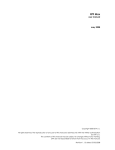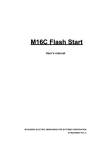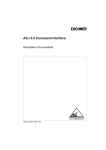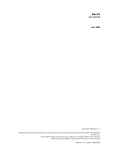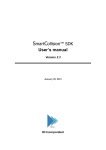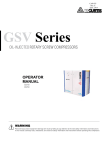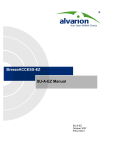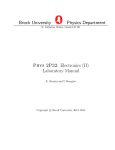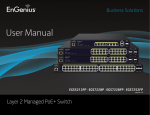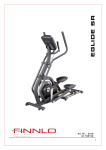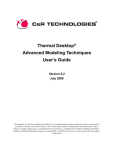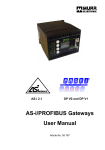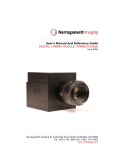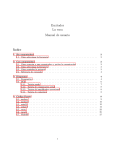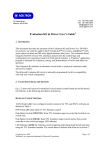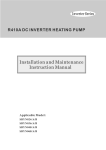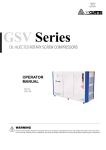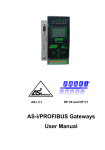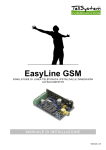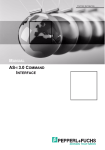Download User Manual - ILPhotonics.com
Transcript
RPF8
FILTER WHEEL
User Manual
December 2005
Copyright 2005 DTA s.r.l.
All rights reserved. The reproduction of any part of this manual is allowed only with the written
authorization by DTA s.r.l..
The contents of this manual may be subject to changes without any warning.
DTA are not responsible for errors that may occur in this manual.
Revision 1.2 dated 19/12/2005
2
CONTENTS
INTRODUCTION
PERSONAL COMPUTER MINIMUM REQUIREMENTS
INSTALLATION OF RPF8 TO YOUR PC BY MEANS OF THE SERIAL LINK
PARALLEL AND SERIAL INTERFACE
RPF8 SETTING
RPF8 ADDRESS SETTING
UPDATING OF THE FIRMWARE
RPF8 CASCADE CONNECTION
SOFTWARE SETTING
RPF8 HANDLER V. 1.0
RPF8.CFG
RPF8 MAX (VER 1.0) N POSITION FILTER WHEEL
PROGRAMMER’S MANUAL
RS232 SERIAL LINK AND TRANSMISSION PROTOCOL
PARALLEL LINK AND TRANSMISSION PROTOCOL
RPF8 COMMANDS SERIAL MODE
CONTROL INSTRUCTIONS
PROGRAMMING AND SETUP INSTRUCTIONS
RPF8 COMMANDS PARALLEL MODE
APPENDIX A
SETTING OF THE TRANSMISSION SPEED ON RS232
APPENDIX B
EEPROM MAP
APPENDIX C
ANSWERING MESSAGES OF THE RPF8
APPENDIX D
DIAGNOSTICS OF RPF8 MAX
APPENDIX E
C SOURCE EXAMPLES
SPECIFICATIONS
OPTIONS
INDEX
4
4
5
6
7
8
10
11
12
13
13
14
15
16
18
19
20
21
22
22
24
24
25
3
INTRODUCTION
RPF8 is an 8-position 2” motorized filter wheel running by means of the following two ports:
1. a standard bidirectional port (parallel port)
2. a RS232 (serial port)
It stands out for its capability to place the 2” filters at high speed (50 ms between one filter and the following
one).
In cascade connection mode, it can control up to 256 RPF8 units by means of the same serial port.
It is possible to set the rotation speed and a different stop position for each filter.
The motor hold current is user adjustable.
This product can be customized, specifying different size, number of filters, input or output adapters.
The typical applications are Photometry, Microscopy and colour sequences.
Fig. 1 RPF8 filter wheel: front and rear views
THE STANDARD SYSTEM INCLUDES:
- assembled unit in light alloy with threaded 2” input;
- RS232/Parallel interface;
- 2.5 m PC parallel link cable;
- managing software for Windows 95/98/ME/XP/2000;
- 230V power supply;
- case, manual and 24 months of warranty.
PERSONAL COMPUTER MINIMUM REQUIREMENTS
•
•
•
•
4
CPU Celeron 1 Ghz .
256 Mb di RAM.
Microsoft Windows 98, ME.
An RS232 port to be used for the connection between the PC and the filter wheel.
INSTALLATION OF RPF8 TO YOUR PC BY MEANS OF THE SERIAL LINK
The following steps are fundamental to install the RPF8 filter wheel to your PC:
¾ It is suggested to make the connession operations with computer off.
¾ Install the software by the use of the floppy provided with the filter wheel, following the indications
there reported.
¾ From the Programs/rpf8 directory, edit the rpf.cfg file, verifying the settings are coherent with the
required ones.In particular, verify the field relative to the used port.
¾ Put the provided serial 9-pin female connector of the link cable (see picture below – A) in the
selected serial port, then fix it by means of the two side screws placed on the connector.
¾ Put the 25-pin female connector (see picture below – B) in the respective 25-pin male connector of
the RPF8, then fix it by means of the screws placed on the female connector.
¾ Put the male jack (out of the 12V power supply provided together with the filter wheel) in the supply
female jack (see picture below – C).
¾ Let run the handly program.
B
A
C
Fig. 2 Serial link cable
5
PARALLEL AND SERIAL INTERFACE
The parallel interface is made up of a link between the RPF8 and the PC on standard bidirectional parallel
port, while the serial interface is made up of a link by means of standard RS232.
Hereafter you can see the 25-pin male connector of the RPF8 as well as the detailed description of the
included signals.
The following chart represents the signals on the pin of the connector
1
AD0
2
6 ERROR 7
11
GND
12
16
AD5
17
21
GND
22
AD2
GND
TX1
AD7
GND
3
8
13
18
23
AD4
POW
TX0
/BUSY
+5V
4
AD6
5
9
ADDR
10
14
AD1
15
19 /STROBE 20
24
RX1
25
/ACK
PRG
AD3
POW
RX0
AD0 – AD7 : COMMAND[0:7] parallel port (input)
/STROBE : /STROBE parallel port signal (input)
/ACK : /ACK parallel port signal (output)
/BUSY : /BUSY parallel port signal (output)
ERROR : notice of parallel port error (output)
GND : ground
POW : +12V RPF8 power supply (input)
+5V : +5V (output)
ADDR : pin of changing address
PRG : pin of firmware updating
TX1, RX1 : UART1
TX0, RX0 : UART0
The communication speed on serial port can be 2400bps, 4800bps, 9600bps, 19200bps (see the relevant
paragraph).
This specific kind of link can get up to a maximum distance of 50 m.
With parallel port up to 20 m.
All signals are standard CMOS 0-5V.
6
RPF8 SETTING
RPF8 ADDRESS SETTING
In serial mode RPF8 is identified by an address. Because of it, you can link up to 256 devices one
after the other. If the wheel doesn’t recognize its input address, it doesn’t answer and it stays transparent.
The address recognized by the RPF8 can be found in location 3Fh of the inner eeprom : DTA places it on
address 0 (see the relevant section of the “ Programmer’s Manual”) : it usually is a read-only .
To modify the RPF8 address, it is necessary to short-circuit the pin 7 (ADDR) and 6 (+5V) of the 9-pin
female connector of the serial cable (see picture 3 – B).
Before performing this step, make sure your device is not powered !
Switch the wheel on and it’ll recognize the 0 address. Now the address can be changed by means of a simple
writing operation at the 3Fh location of the eeprom : only the lowest significant byte is valid. Once this
operation is over, switch the device off and eliminate the short-circuit. When getting started, the filter wheel
will recognize the new set address.
Otherwise, you can simply realyze the identity address programming by means of the rpf.exe handly
program, just typing from the command console the following:
rpf /s n
where n is the address ranging from 0 to 255.
A
B
Fig. 3 A: Serial cable; B: detail
7
UPDATING OF THE FIRMWARE
RPF8 hosts a powerful microchip running every function with a re-plannable and updatable firmware. To
plan the firmware you need to build up a serial cable linking the wheel to the PC. Hereafter you can find the
chart.
RPF8 PORT
CANNON 25 F
SIGNAL
UART 1
CANNON 9 F
1
2
3
4
5
6
7
8
9
10
-------POW
--
-----------
11
12
13
14
15
16
17
18
19
20
21
22
23
24
25
TO BE SHORT-CIRCUITED
WITH PIN 23/
GND
TX1
--------GND
-TO BE SHORT-CIRCUITED
WITH PIN 10
RX1
--
5
2
------------
POWER SUPPLY
JACK
NOTES
CENTRAL
+12V
PRG
SERIAL GND
UART1 TX
EXTERNAL
3
--
POWER S. GND
VCC +5V
UART1 RX
CHART OF RPF8 PLANNING CABLE
Please note: the power-supply jack has to be mounted as an output from the connector of
UART1.
8
Fig. 4 RPF8 programming cable
In order to get to the programming stage, you also need to have the updated software as well as the
microcontroller programming software “M16C Flash Start (MSA0806)”
Here follow the steps to do in order to obtain the right updating of the software.
⇒ Switch the PC off, any device included.
⇒ Link the RPF8 to the PC by using the dedicated programming cable.
⇒ Feed the RPF8 and switch the PC on.
⇒ Start the software M16C Flash Start (MSA0806) and follow the instructions.
⇒ Once the programming has been carried out, switch both the PC and the wheel off. Then change the
programming cable with the communication one.
⇒ The wheel is ready to be used again.
9
RPF8 CASCADE CONNECTION
You can get a cascade connection, up to 256 units, thanks to the serial link. The first cascade RPF8
needs to be connected to the PC, the second by means of the 9 pin female connector(see picture 5 –
A) of its own cable to the 9 pin male connector (see picture 5 – B) of the previous wheel and so on.
A
B
Fig. 5 Serial cable
10
SOFTWARE SETTING
RPF8 HANDLER V. 1.0
Together with the RPF8 you are given a software controlling the wheel by means of serial port “RPF8
HANDLER V. 1.0”.
It allows one to manage the wheel with Win9x/ME/NT/2000/XP.
To install the managing program just start “setup” from the CD you can find in the wheel box.
This software looks for the wheel on the COM1.
Once the setting is finished, the program shows the presence of a single RPF8 as a default, with suitable
working parameters set by default.
To enable the control of more than one wheel and change the wheel parameters, it is necessary to edit the file
“rpf8.cfg” (as shown in the following page of this manual) : it is in the same directory as the software already
installed.
Switch the RPF8 on, then start the software. The wheel is ready to be used.
11
RPF8.CFG
**** Specify num of filter wheel in the same serial channel, range: 1..8
1
**** Specify num of filters on each fw, range: 8..16
8
**** Specify serial port, range: 0..15, 0 = COM1.. 15 = COM16
0
**** Specify baud rate, range: 3 = 2400, 4 = 4800, 5 = 9600, 6 = 19200
6
**** Enable holding torque: 0 = disable, 1 = enable
1
**** Set holding torque, range: 10..15984. 1 count = 62.5 ns of the ON period
15984
**** Filter offset, range: -127 to + 128. Applied after calibration
0
**** Calibration speed, Freq. (KHz) = 2/n. Range: 20000..10000
20000
**** Slope used in fast positioning, value are motor steps, range: 0..255
224
**** Start speed in fast positioning, Freq. (MHz) = 16/n. Range 32768..65535
65535
**** End speed in fast positioning, Freq. (MHz) = 16/n. Range 0..65535. 4096 for Sanyo-Denky, 16000 for MAE
4096
**** Enable (1) or disable (0) feedback positioning.
1
**** Delay after positioning (ms). Range: 0..65535. Suggested value: Sanyo-Denky 125, MAE 500
125
PLEASE DON'T CHANGE THE ORDER OF THESE PARAMETERS, AND DON'T ADD BLANK
LINES BETWEEN THESE.
MAX LENGTH OF A LINE IS 256 CHARS.
12
RPF8 MAX (VER 1.0) N POSITION FILTER WHEEL
PROGRAMMER’S MANUAL
RPF8 has two different connection systems : by means of parallel port or serial port.
On the contrary, the programming has been designed to be driven from the serial port only. The filter wheel
recognizes if the communication has been set by serial or parallel port automatically.
As soon as the device is on, it starts reading all the start-up settings from the inner EEPROM. Immediately
after, thanks to a calibration stage, it is located in filter number 0.
The device is identified by an 8-bit address serially, so you can connect up to 256 RPF8 in the cascade mode.
Hereafter you can find the protocol transmission specifications.
RS232 SERIAL LINK AND TRANSMISSION PROTOCOL
The RS232 serial link is used with the following transmission parameters : either
2400, N, 8, 1 or 4800, N, 8, 1 or 9600, N, 8,1 or 19200, N, 8, 1 (see Appendix A : Setting of transmission
speed upon RS232).
The protocol uses printable ascii characters.
Every transmitted string consists of a head “$” character, an end-field “#” character and end-string character
represented by the CR (13) character.
Between the # character and the CR one, there are two hexadecimal figures showing the 8-bit checksum of
the string ( it is calculated from $ character to #, excluding these 2). Immedaitely after the head “$” character
you’ll find the RPF8 address (00-FF) one wishes to use. You will be asked to provide 2 hexadecimal figures,
up to a maximum range of 256 devices. For every string transmitted to the wheel, it corresponds to another
one standing for the answer : it is the command processing confirmation. If the command has been carried
out, the answer can be ACKXX, on the contrary NAKXX. Instead of the ACKXX, a requested status can be
sent.
Command string format
$ Addr Command # cksm CR
typical answer
$ Addr ACKXX#Cksm CR
If the address field does not include any valid value, no device will answer. Every RPF8 answers after the
carrying out of the command, the minimum response time being 20ms.
The checksum is calculated by summing up every character included between the $ character and the # one
(excluding these 2) on a 8-bit accumulator.
By means of the Command string, the instructions are given to the wheel. Command has a dimension
ranging from from 1 to 7 characters.
13
PARALLEL LINK AND TRANSMISSION PROTOCOL
The link is performed thanks to a 8-bit standard parallel port.
The protocol is as follows.
o
o
o
o
o
COMMAND [7:0] INPUT
/STROBE INPUT
/ACK OUTPUT
/BUSY OUTPUT
ERROR OUTPUT
The RPF8 waits for the input /STROBE signal to become low, then it reads COMMAND [7:0] and lowers
/ACK and /BUSY; it waits for /STROBE to come back to 1 in order to bring /ACK back to 1, then it goes
on with the interpretation and execution of the command which it has just received.
At the end of the execution, it carries /BUSY up to 1 and it sets or resets the ERROR flag according to any
error which might have occurred or not.
The word COMMAND [7:0] consists of : the 3 most significant bits (command [7:5]) identify the
command, the other 5 bits (command [4:0]) contains the data.
14
RPF8 COMMANDS SERIAL MODE
In serial mode, RPF8 shows 24 instructions allowing the control of the wheel and the planning of all
parameters ( from the address to the number of filters and to the pilotage setting up of the stepping motor).
Ai and Di fields are expressed in hexadecimals.
What follows is the comprehensive list of the instructions.
CONTROL INSTRUCTONS
o VERSION code 0
As an answer, RPF8 transmits a string concerning the revision of the firmware ( “RPF8 MAX
VER 1.0”).
code 1
RPF8 performs the adjusting by placing on filter number 0; if the adjustment has been successful,
it transmits the string ACK00, otherwise the string ACK01 (it means that the adjustment can’t be
carried out).
o
CALIBRATE
o
PLACEMENT code 2D1D0
RPF8 goes onto the filter whose number is specified by the 2 figures D1D0 in hexadecimal. Once
the placement has been carried out, the wheel shows the string ACK00. If the number specified in
the the instruction isn’t valid (as it exceeds the number of filters which the wheel can host), the
placement doesn’t come to an end and the wheel transmits the string NAK01 (unrecognized
instruction). On the other hand, if the placement can’t be performed because of a hardware failure,
the wheel may transmit the string ACK02 (the placement has not taken place) or the string ACK01
(the recalibration has not taken place).
o
TORQUE code
o
STATUS code
o
POSITION
o
DIAGNOSTIC code T
RPF8 carries out four series of automatic positionings, able to verify the correct working of both
the mechanics and the electronics (see Appendix D). For every performed positioning the wheel
transmits either the string ACK00 or ACK01 or ACK02, according to the positioning outcome. At
the end of the test, an hexadecimal number is given back showing how many errors have taken
place.
o
D_REPORT code RI0
This instruction allows one to enter four strings (I0 = 0-3) showing the latest diagnostic test (see
APPENDIX D).
9D0
This instruction allows one to apply (or not to do so) a holding torque to the motor of the RPF8 (if
it is still); D0 = 1 if you need to activate the torque, D0 = 0 if you need to disactivate it. The RPF8
transmits the string ACK00.
S
This instruction allows one to ask for the inner status of the RPF8 corresponding to the latest
placement instruction or calibration which has been performed. As an answer, the wheel can either
transmit the string STATUS00 showing that no error has occurred, or STATUS1 showing that a
calibration error has happened, or STATUS2 in case of a placement error.
code P
RPF8 gives back a string specifying the number of the filter currently in placement.
15
PROGRAMMING AND SETUP INSTRUCTIONS
You are kindly recommended to use the wheel parameters as shown in Appendix B
16
o
TORQUE_VAL code 3D3D2D1D0
The holding torque value depends on the length of the high level of a 1 Khz square frequency wave
applied to the motor. This value is set by means of the four hexadecimal figures D3 - D0 (16 bit).
Every count is equivalent to an interval of 62,5ns. The minimum value to be set is 000Ah, the
maximum 3E70. The RPF8 transmits the string ACK00.
o
OFFSET
o
FILTERS code 5D1D0
This instruction allows one to set the number of filters you can mount on the wheel (it depends on
the internal disk), up to 256 (D1D0 = FF). RPF8 transmits the string ACK.
o
STEPS code
o
CIRCLE code 7D2D1D0
This instruction allows one to set the number of motor steppings to perform a full circle of the
wheel, the number being specified by means of the three hexadecimal figures D2D1D0. RPF8 shows
the string ACK00.
o
MOTOR_S
o
RAMP code
o
MSTEPI code BD3D2D1D0
This instruction allows one to set the initial pilotage frequency of the stepping motor as far as the
placement stage is concerned. The frequency (MHz) is equivalent to 16/MSTEPI . RPF8 transmits
the string ACK00.
o
MSTEPF code
code 4D1D0
This instruction allows one to set a number of steps the wheel has to carry out at the end of the
calibration, by going on with the rotation trend or by inverting the rotation itself. The number of
steps ranges from –127 (D1D0 = 00) to + 128 (D1 D1 = FF) – the negative sign stands for the
inversion of the rotation -. The RPF8 transmits the string ACK00.
6D2D1D0
This instruction allows one to set the number of motor steppings between one filters and the next
one, the number being specified by means of the three hexadecimal figures D2D1D0. RPF8
transmits the string ACK00.
code 8D3D2D1D0
This instruction allows one to set the pilotage frequency of the stepping motor during the
calibration stage. The frequency (KHz) is equivalent to 2/N (N stands for the the number with 16
bit set by D3D2D1D0). RPF8 transmits the string ACK00.
AD1D0
This instruction allows one to specify the length (by motor steppings) of the
acceleration/deceleration ramp of the motor during the placement stage. RPF8 transmits the string
ACK00.
CD3D2D1D0
This instruction allows one to set the maximum pilotage frequency of the stepping motor as far as
the placement stage is concerned. The frequency (MHz)is equivalent to 16/MSTEPF. RPF8
transmits the string ACK00.
o WRITE_EE code DA1A0D3D2D1D0
This instruction allows one to write in the inner eeprom : it’s the place where all pilotage
parameters of the device are memorized. By means of A1A0, one specifies the inner memory
address to be entered (ranging from 00h to 3Fh). The data to be written are given D3D2D1D0. RPF8
transmits the string ACK00.
o
READ_EE code EA1A0D3D2D1D0
This instruction allows one to read in the inner eeprom : it’s the place where all pilotage parameters
of the device are memorized. By means of A1A0, one specifies the inner memory address to be
entered (ranging from 00h to 3Fh). The RPF8 transmits the string including the data of the memory
location.
o
DIP_SW code
o
IR_CTRL codifica VD1D0
This instruction allows one to switch the positioning and calibration sensors on and off. If you set
D1 at 1, the sensor controlling the wheel position turns on; if you set it at 0, it turns off. If you set
D0 at 1, the sensor controlling the wheel calibration turns on; if you set it at 0, it turns off.
o
IR_READ code I
This instruction allows one to read the information coming from by both positioning and
calibration sensors. Two figures are given back, C1 C0, showing (if at data 1) the performed
positioning or calibration respectively.
M
This instruction allows one to get the status of the 8 inner dip switch (see APPENDIX A)
N.B.
C1 has to be at value 1 for every position of the wheel, while C0 has to value 1 in position ZERO
only (calibration positioning).
o
POS_FEEDBACK code LD0
This instruction allows one to enable (or not to do so) the feedback control of the positioning. If D0
is placed at value 1, the feedback has been activated; if it is placed at value 0, the feedback is
disactivated.
FEEDBACK NOTE
The feedback function allows the RPF8 micro to check the maintenance of the current position
before a new positioning might start. If the current position has gone lost (due to special, external
cause), the RPF8 carries out a calibration and then it shifts into the new position.
o DELAY code KD3D2D1D0
This instruction allows one to trim the waiting delay at the end of every positioning of the RPF8. In
this way the oscillations (due to the inertia of the system) are reduced. The delay time corresponds
to D3D2D1D0 ms.
17
RPF8 COMMANDS PARALLEL MODE
In this mode, the RPF8 include a reduced command set allowing one to drive the wheel and enter a limited
section of its parameters.
o
CALIBRATE
0
COMMAND
0
0
-
-
DATA
-
-
-
The RPF8 performs the calibration by placing itself on filter number 0 again. If the calibration
can’t be carried out, it sets ERROR at value 1.
o
POSITION
0
COMMAND
0
1
D4
D3
DATA
D2
D1
D0
The RPF8 goes to the filter whose number is specified by the five binary figures D4D3D2D1D0. If
the positioning can’t be carried out, the RPF8 sets ERROR at value 1.
o
TORQUE_VAL
0
COMMAND
1
0
D4
D3
DATA
D2
D1
D0
The value of the holding torque depends on the length of the high level of a 1 Khz square
frequency wave applied to the motor. This value is set by means of the five binary figures D0 - D4.
Every count is equivalent to an interval of 625ns. The minimum value to be set is 00001 b, the
maximum 11111 b.
o
OFFSET
0
COMMAND
1
1
D4
D3
DATA
D2
D1
D0
This instruction allows one to set a number of steps the wheel has to carry out at the end of the
calibration, by going on with the rotation trend or by inverting the rotation itself. The number of
steps ranges from –15 (D4D3D2D1D0 = 00000) to + 16 (D4D3D2D1D0 = 11111) – the negative sign
stands for the inversion of the rotation .
o
TORQUE
1
COMMAND
0
0
-
-
DATA
-
-
D0
This instruction allows one to activate or disactivate the holding torque of the stepping motor. If
D0 is placed at value 0, the holding torque is disactivated; if it is placed at value 1, the holding
torque is activated.
18
APPENDIX A
SETTING OF THE TRANSMISSION SPEED ON RS232
The two serial ports RS232 of the RPF8 (UART0 and UART1) can communicate at a speed of 2400
bps, 4800 bps, 9600 bps and 19200 bps. DTA has set it at 19200 bps; however, you can modify it by
using the dip switches 1 and 2 you can find inside the RPF8. Hereafter you can look at the settings of
the two switches to select the four speed.
8
7 6
5 4 3
8 7 6 5 4
2 1
3 2 1
on
on
SETTINGS
8
7 6
19200 bps
5 4 3
on
SETTINGS
2 1
8 7 6
9600 bps
5 4 3 2 1
on
SETTINGS
4800 bps
SETTINGS 2400 bps
PLEASE NOTE : THE DIP SWITCH POSITION 3 – 8 ARE NOT USED!
19
APPENDIX B
EEPROM MAP
The EEPROM includes every value relevant to any RPF8 parameter. Thanks to this every time the wheel is
on the internal microcontroller loads the functioning parameters automatically.
ADDRES
DATA
Ind. 00h
Ind. 01h
Ind. 02h
Ind. 03h
Ind. 04h
Ind. 05h
Ind. 06h
Ind. 07h
Ind. 08h
Ind. 09h
Ind. 0Ah
Ind. 0Bh
Ind. 0Ch
Ind. 3Fh
CPVH
OFFSET_VAL
FILTERS
STEPS
CIRCLE
MOTOR_S
RAMP
MSTEPI
MSTEPF
TORQUE
OFFSET_PS
POS_CTRL
DELAY
ADDRESS
SANYO MOTOR
MAE MOTOR
3E70h
007Fh
0008h
0064h
0320h
4E20h
00E0h
FFFFh
1000h
0001h
0000h
0001h
007Dh
0000h
3E70h
007Fh
0008h
0064h
0320h
4E20h
00E0h
FFFFh
3E80h
0001h
0000h
0001h
01F4h
0000h
CPVH : length of the high level of square wave running the holding torque (acceptable range
000Ah – 3E70h).
OFFSET_VAL : offset value for calibration.
FILTERS : number of filters of the inner disk.
STEPS : number of motor steppings between one filter and the following one.
CIRCLE : number of motor steppings for the full rotation of the wheel.
MOTOR_S : it sets the pilotage frequency of the motor in calibration mode.
Freq.(KHz) = 2/MOTOR_S.
RAMP : number of motor steppings of the acceleration/deceleration ramp in the positioning stage.
MSTEPI : it sets the initial pilotage frequency of the motor in the positioning stage. Freq.( MHz)
= 16/MSTEPI.
MSTEPF : it sets the final pilotage frequency of the motor in the positioning stage. Freq.( MHz) =
16/MSTEPF.
TORQUE : if this parameter is set at value 0, the holding torque is disactivated; if it is, set at
value 1, it is activated.
OFFSET_PS : if this parameter is equivalent to 0, it means that the OFFSET_VAL value has been
set by serial port; otherwise, if this parameter is equivalent to 1, it means that the OFFSET_VAL
value has been set by parallel port..
POS_CTRL : if this parameter is set at value 1, the feedback positioning starts working; if it set at
value 0, the control is disactivated.
DELAY : it’s the gap in ms between a positioning and the other.
ADDRESS : this parameter sets the RPF8 serial address.
N.B.
The not bold value of the eeprom location is not significant.
20
APPENDIX C
ANSWERING MESSAGES OF THE RPF8
ERROR MESSAGES
Hereafter you can find a list of error messages the RPF8 can give back as a result of the receipt of an
instruction by means of serial port.
NAK00 : receipt error; the input string can’t be decoded.
NAK01 : unrecognized or wrong instruction.
ACK01 : the calibration has not taken place; the reason is an hardware problem. Try to clean the
infrared positioning sensor with a jet of compressed air : it is placed underneath, outward the
filter disk.
ACK02 : the positioning has not taken place; the reason is an hardware problem. Try to clean
the infrared positioning sensor with a jet of compressed air : it is placed underneath, inward the
filter disk.
ACK03 : the operation is not allowed; this string is given back if you try to modify the address
of the filter wheel without having shot-circuited the ADDR pin (as specified in the paragraph
“Setting of the RPF8 address”).
AVVIA DIAGNOSTICA : you have carried out the D_REPORT command without carrying
out the diagnostic before.
.
DIAGNOSTIC MESSAGES OF THE INTERNAL STATUS
Hereafter you can find a list of internal status messages the RPF8 can give back as a result of the receipt of
the STATUS instruction (only from serial port).
STATUS00 : the last performed calibration or positioning instruction has been successful, the
wheel is working properly.
STATUS01 : the last performed calibration instruction has been unsuccessful. Try to clean the
infrared positioning sensor with a jet of compressed air : it is placed underneath, outward the
filter disk.
STATUS02 : the last performed positioning instruction has been unsuccessful. Try to clean the
infrared positioning sensor with a jet of compressed air : it is placed underneath, inward the filter
disk.
.
SUCCESSFUL EXECUTION MESSAGES
Hereafter you can find a list of messages showing a successful outcome as far as the execution of the
instructions given by serial port.
ACK00 : the instruction has been performed properly. This string is the answer to all the given
and carried out instructions but the VERSION instruction.
RPF8 MAX VER 1.0 : the VERSION instruction has been properly performed; the string
specifies the revision of the internal firmware.
21
APPENDIX D
DIAGNOSTICS OF RPF8 MAX
The RPF8 can carry out an autodiagnostic test allowing to check the right calibration of both the mechanics
and the electronics as well as the absence of any incorrect working stages. By means of the DIAGNOSTIC
(T) command, the wheel is asked to perform four positioning series : first the wheel carries out a calibration,
then it is placed on every filter included between 0 and N-1 (N = number of positions of the wheel) like in a
sequence. If the positioning fails, the wheel performs a calibration before stepping into the following filter.
In the second series, the wheel is placed on the filters according to the following rule :
For X = 0; X<N/2; X++;
{POSITION =N/2+X;
POSITION =X;}
If a positioning fails, the wheel performs a calibration before stepping into the following filter. The other two
series are the same as the ones we have just mentioned.
At every series corresponds a string with N bit (binary figure) (the first being N + 1 as it also include the
outcome of the initial calibration) : here it is shown the outcome of every single positioning (0 means
“performed”; 1 stands for “error”). The figure on the extreme left refers to position 0, the other on the
extreme right to the position N-1, except for the first string (in this case, on the extreme left you can see the
outcome of the calibration). You can get to the strings through the instruction D_REPORT (RI0) – I0 ranges
from 0 to 3.
APPENDIX E
C SOURCE EXAMPLES
Hereafter it is shown a C example RPF8 string encoding and transmission
void TxStr(char *tx, int len)
{
unsigned char cksm = 0, ch;
int
c;
TxByte('$');
// *tx is the string code for the RPF8
// len is the lenght of the code
// standard function byte transmission
// on a serial port
// send $
// *** start of address sending
ch = ByteHex((Addr >> 4) & 0x0F); // this function translate a bynary
// value to an hex character
TxByte(ch);
cksm += ch;
// checksum calculation
ch = ByteHex(Addr & 0x0F);
// this function translate a bynary
// value to an hex character
TxByte(ch);
// *** end of address sending
cksm += ch;
for(c = 0; c < len; c++)
{
TxByte(tx[c]);
cksm += tx[c];
}
TxByte('#');
22
// *** start of code sending
// *** end of code sending
// send #
ch = ByteHex((cksm >> 4) & 0x0F);
TxByte(ch);
ch = ByteHex(cksm & 0x0F);
TxByte(ch);
TxByte(13);
// *** start of checksum sending
// *** end of code sending
// send CR (13)
}
Hereafter it is shown a C example of string decoding from RPF8
int RxStr(char rx, int len, long tout)
//*rx is the decoded string
// from RPF8
{
unsigned char cksm = 0, rcksm, add;
int
c;
char *bufrx = 0;
bufrx[0] = bufrx[1] = 0;
sread(bufrx, &c, tout); //this function receive a string from serial
//input the string ends with CR character
if(bufrx[0] != '$')
//controls that first character is $
return 1;
add = HexBin(&bufrx[1]); //decode address from hex char to bin value
if(add != Addr)
return 2;
cksm += bufrx[1];
//checksum calculation
cksm += bufrx[2];
for(c = 3; c < 80; c++)
// extract the code returned from RPF8
{
// from serial string
if(bufrx[c] != '#')
{
cksm += bufrx[c];
rx[c - 3] = bufrx[c];
}
else
{
c++;
rcksm = HexBin(&bufrx[c]);
//controls the checksum
rx[c-4]=0;
break;
}
}
if(rcksm != cksm)
return 1;
*len = c - 3;
return 0;
}
23
SPECIFICATIONS
POSITIONING SPEED
0.05 s
NUMBER OF POSITIONS
8
STANDARD MOUNT
2’’
SPEED CONTROL
Yes
SERIAL INTERFACE
RS232 2400 9600 Baud
PARALLEL INTERFACE
8+4 bit input, 1 bit output
MAXIMUM FILTER THICKNESS
10 mm
BACKFOCUS
25 mm
POWER SUPPLY
12V 1A
DIMENSIONS
Φ 225 mm
OPTIONS
RGB-8
50 mm RGB interference filter kit
NIK-8
Adapter for Nikon lens
MIN-8
Adapter for 42x1 mm lens
AR-8
Adapter for HiRes
PAR-8
Standard parallel port link cable
Link-2
Link cable for 2 RPF8 units with 2.5 m wheel base
Link-4
Link cable for 4 RPF8 units with 2.5 m wheel base
Link-8
Link cable for 8 RPF8 units with 2.5 m wheel base
24
INDEX
A
APPENDIX A
APPENDIX B
APPENDIX C
APPENDIX D
APPENDIX E
ANSWERING MESSAGES OF THE RPF8
19
20
21
22
22
21
C
CONTROL INSTRUCTIONS
C SOURCE EXAMPLES
15
22
D
DIAGNOSTICS OF RPF8 MAX
22
E
EEPROM MAP
20
I
INTRODUCTION
INSTALLATION OF RPF8 TO YOUR PC BY MEANS OF THE SERIAL LINK
4
5
O
OPTIONS
24
P
PARALLEL AND SERIAL INTERFACE
PARALLEL LINK AND TRANSMISSION PROTOCOL
PERSONAL COMPUTER MINIMUM REQUIREMENTS
PROGRAMMER’S MANUAL
PROGRAMMING AND SETUP INSTRUCTIONS
6
14
4
13
16
R
RPF8 ADDRESS SETTING
RPF8 CASCADE CONNECTION
RPF8.CFG
RPF8 COMMANDS PARALLEL MODE
RPF8 COMMANDS SERIAL MODE
RPF8 HANDLER V. 1.0
RPF8 MAX (VER 1.0) N POSITION FILTER WHEEL
2RPF8 SETTING
RS232 SERIAL LINK AND TRANSMISSION PROTOCOL
9
1
14
20
17
13
15
9
15
25
S
SETTING OF THE TRANSMISSION SPEED ON RS232
SPECIFICATIONS
SOFTWARE SETTING
21
26
13
U
UPDATING OF THE FIRMWARE
26
10
s.r.l.
Viale Campania 23
56021 Cascina (Pisa) - ITALY
web site: www.dta.it
e-mail: [email protected]
27



























